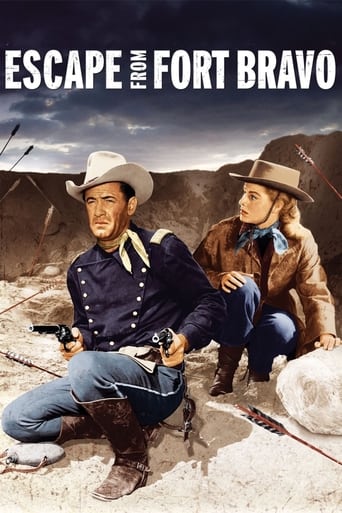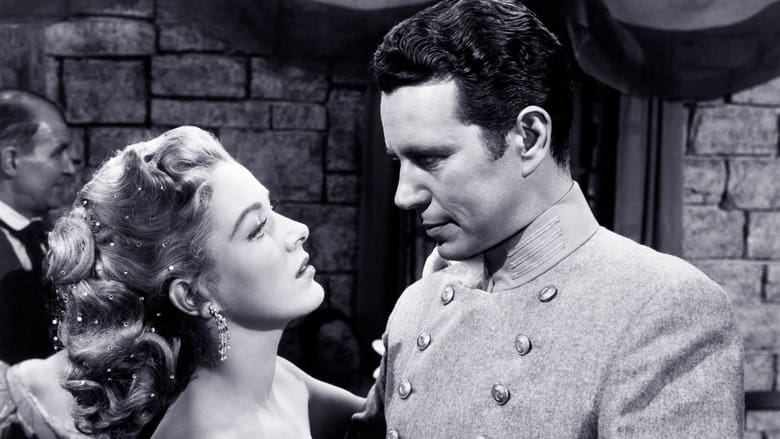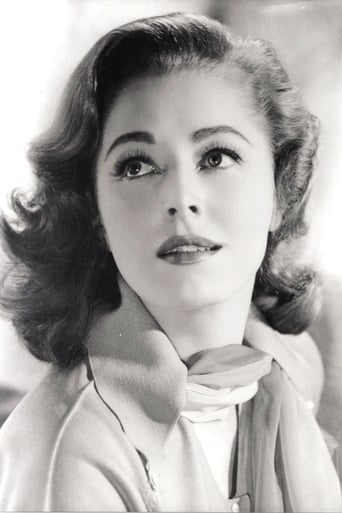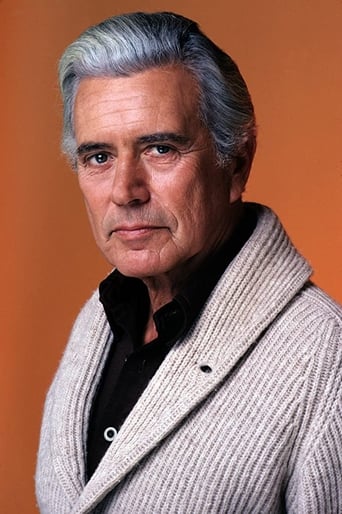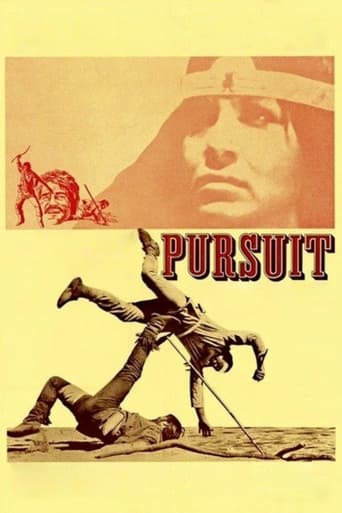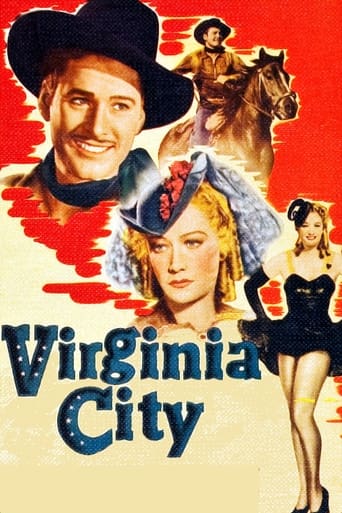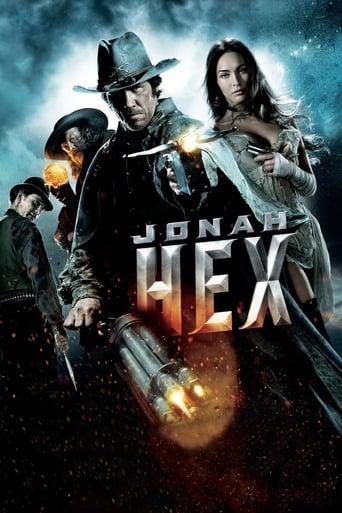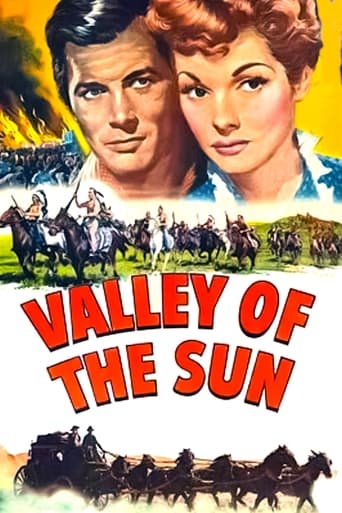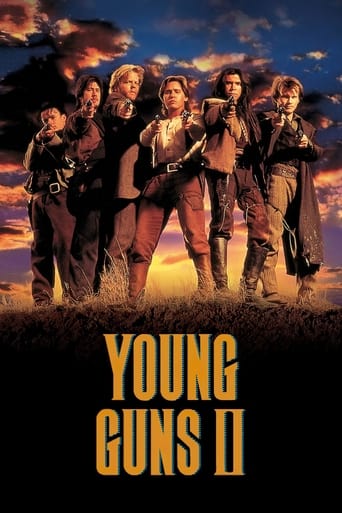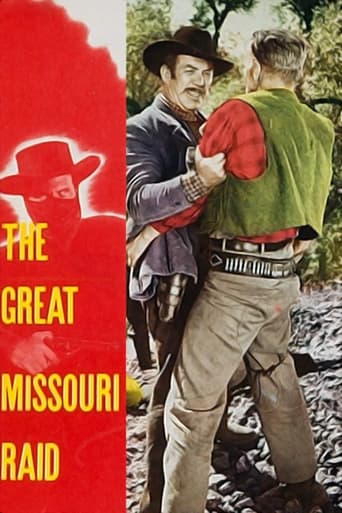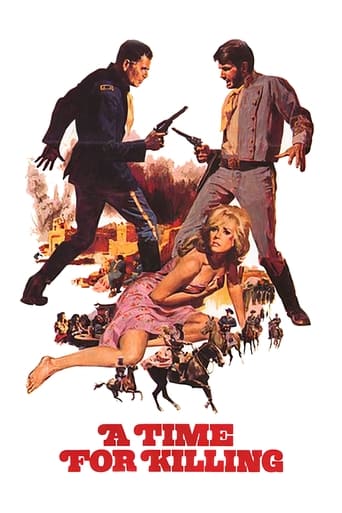Escape from Fort Bravo (1953)
A Southern belle frees a Rebel officer and his men from a Union captain's Arizona fort.
Watch Trailer
Free Trial Channels
Cast


Similar titles
Reviews
This Movie Can Only Be Described With One Word.
Plot so thin, it passes unnoticed.
Instead, you get a movie that's enjoyable enough, but leaves you feeling like it could have been much, much more.
Clever, believable, and super fun to watch. It totally has replay value.
The story is set during the Civil War. For some reason, a Union prisoner of war camp is set way, way out west around the territory of the Mescalero Apache (which is around Southern New Mexico, though they were a nomadic tribe). When some of the Southern soldiers escape, it's up to the tough-as-nails Captain (William Holden) to track them down...or die trying. The problem is that eventually, when he does find the POWs, they're ALL at the mercy of the landlords...the Mescalero...and apparently they DON'T like squatters!While in some ways the film is pretty decent, I really felt annoyed by much of the action. Again and again, the Mescalero warriors just rode around and around and around their horses...WAITING to be shot! They often didn't even fire back...just rode by as the soldier's shot at them! Only later did the Mescalero act with any sense of intelligence...which was kind of insulting AND stupid. The casting decisions in this film were a bit odd. While it seemed odd seeing William Demerest as a Confederate soldier, it seemed REALLY odd to see John Forsythe, with his lovely Northern accent!So is it worth seeing? Well, I'd put it in the category of 'Time Passer'...a film that is modestly entertaining but nothing more. Little about the movie excited me one way or the other.
Directed by John Sturges, this average Western set in 1863 combines elements of the Civil War with the struggle against the Mescalero Indians in settling the West. The Union Army maintains the titled stockade for some Southern Confederate prisoners in Arizona (actually filmed in Death Valley, California).Given the remote, desert location, the prisoners aren't likely to attempt escape without horses, or the guns needed to defend themselves against the Natives. So, it works pretty well. However, when one of the Southerners (John Lupton) does escape, Captain Roper (William Holden) feels it's necessary to make an example of him to keep others from trying the same - he makes him walk back! Captain Marsh (John Forsythe), as the leader of the Confederates, is not too happy about Roper's cruel and unusual punishment, but has a plan for he and a few others to escape. These others include the coward Bailey (Lupton), crotchety old Campbell (William Demarest), and young "buck" Cabot (William Campbell). Campbell and Cabot maintain a love-hate relationship.Colonel Owens (Carl Benton Reid) isn't too pleased with Roper's exhibition either, but he also realizes that Roper is the soldier who always gets his man too. Roper's subordinate, Lieutenant Beecher (Richard Anderson), who's about to marry the Colonel's daughter Alice (Polly Bergen), doesn't approve of Roper's methods either. Alice's cousin, Carla Forester (Eleanor Parker), comes to visit. En- route, Carla's stagecoach is attacked by some Mescaleros such that she's rescued by Roper's men on patrol. Alex Montoya and Western veteran Glenn Strange appear, uncredited, as Sergeants under Roper's command.Roper soon falls for the lovely, bold newcomer who we soon learn is betrothed to Marsh, and part of his escape plan. While Roper is distracted by his infatuation with Carla, she plots with the local storekeeper, and Southern sympathizer Watson (Howard McNear, uncredited) to affect their escape during the Beecher-Owen wedding reception. Later, it is clear that Carla has feelings for Roper such that she feels she too must escape with Marsh et al.Of course, Roper must pursue the escapees. Even though he knows, per the Colonel, that he was duped by Carla, he fears for her life because of the Mescalero Indians. Not exactly trusting his commander's intentions, the newlywed Beecher insists on going along as well. Naturally, Roper (and the few he takes with him) catches up with them, perhaps too easily, but on the way back to Fort Bravo, they are attacked by the Mescaleros.Under siege by superior numbers, Roper uses his military experience to find them the best possible place to mount their defense, a dugout. This "hole" works well, except for the fact that it is soon surrounded, leaving them, with limited water supplies and no horses, trapped. With virtually no other options, the soldiers, Union and Confederate, work together to stay alive. The film's most interesting action (battle) sequences, which include its climax, follow. Carla figures in the equation too.
William Holden excelled at Westerns ("The Wild Bunch", "Alvarez Kelly", "Streets of Laredo", "The Horse Soldiers" & "The Man From Colorado" to name a few), as he did in almost every film he was in. This film is no different. What makes it work is the complexity of the character Capt. Roper. This is a man who is as tough as nails, and makes Javert (From Les Miserables) seem like a normal person, the way he hunts down Confederate Prisoners like animals (Like he did with Bailey (John Lupton)). Yet, he does stuff like grow roses "Roper's Roses", and really hates his job. I love the relationship between him and Carla Forester (Eleanor Parker), who is very much his opposite. A Confederate Spy who is engaged to Capt. Marsh (John Forsythe), and breaks him out of the stockade, and goes with him, not because she wants to, but because of duty and obligation. Marsh, who is the other major character in the film, is a very interesting character, he seems to know that things will not work out the way he planned. Spoilers ahead. He knows that Carla really belongs to Roper, like when he had to snap at her to go with him when he and the other Confederate Soldiers escaped, and when after a fight, he told Roper that Carla fell in love with him, and she only did her duty (Helping them escape). Finally he died with a smile on his face when Bailey (The only Confederate soldier to survive),learned from Roper & Marsh how to be a hero, by escaping the Indians, and instead of running away, like he did earlier, he went back to the fort, and brought back the soldiers to save Roper, Carla, and Lt. Beecher (Richard Anderson). He also knew that Roper was the right person for Carla, because of his willingness to sacrifice himself for her and Beecher (When he went out to face the Indians alone, just before the Calvary showed up). This film deserves my highest praise 10/10
William Holden is as tough as nails, a captain at isolated Fort Bravo, which houses a horde of Confederate prisoners and is surrounded by hostile Mescalero Apaches. Eleanor Parker, as a visitor from Texas, insinuates her way into the fort. Her mission: to arrange for the escape of her lover, John Forsythe, and a handful of other rebels. Alas, during her time at the settlement, she falls for Holden and he for her. This doesn't deter her from her duty.Holden and another officer ride after the escapees and capture them but before they are able to return to Fort Bravo they are surrounded and pinned down by Apaches. Only a few escape the trap alive.The cinematography is by Robert Surtees and it's magnificent. The film was shot on location in Death Valley and the red rock country near Gallup, New Mexico. The images -- those that were not obviously shot on a sound stage -- are some of the best things about the movie.The performances, too, are adequate if not outstanding in any way. How can you be outstanding when you're playing a cardboard character? This was directed by John Sturges who, as usual, does a journeyman job. Okay, so everyone's wardrobe is neat, not only clean but looking brand new, but Sturges ordinarily has his characters neater than those of other directors.The chief problem is with the script. It's full of stereotypes and cinematic clichés. For instance, it's not merely than the Indians are thoroughly bad. (They tie down prisoners over ant hills and allow them to be stung to death.) The Indians could be pretty rough while waging war, especially Apaches. But do they have to be STUPID too? When they pin down some union soldiers, they ride in circles around them, waiting to be picked off one by one, like ducks in a shooting gallery.The costumier, Helen Rose, and the director have muffled their skills. The ladies wear bright new dresses unlike anything seen in period photographs. At one point, Eleanor Parker wears a striped see-through dress, like a modern, fluffy silk blouse. No kidding. The hair styles likewise merely nod in the general direction of the early 1860s. Polly Bergen sports what (I think) used to be called an Italian haircut in the 1950s. Didn't Rose and Sturges ever take a look at portraits? Man, the women's hair styles and clothes were UGLY. Their hair tended to be severely parted in the middle and hung in unsightly loaves down their cheeks. The bodices were tight and the skirts looked like they were held outward by unfolded umbrella spokes. Well, I'm no expert on the subject. I was just a child at the time. Holden wears a tailored uniform with brass buttons that is so tight that it seems made of spandex. He wears no undershirt beneath that spotless blue blouse, so when he peels it off we get to see his muscles and hairy chest. One winces at the historical sloppiness, although it's nice to be spared some of that ugliness. Well, let me put it this way, without going on about it any longer. It's nothing like the clothing or sets of a John Ford cavalry movie. There, the clothing and sets weren't glamorized. They looked lived in, while these don't.The love story is improbable. Holden dances once with Parker, takes her for a ride through the countryside, puts his arms around her waist from behind. "What makes you so sure of yourself?", she asks. "You do?" "Oh? And why?" Holden murmurs, "The way you light a man's cigar." I'm not sure the writer meant that to be clever because he shows no such wit elsewhere in the script. The next day, Holden, the man of titanium, proposes to her.But there's no doubt about the tension and sense of place in the final scene. Half a dozen people from the fort are trapped behind a low barrier of sand or silt. When I first saw this, something about the special effects impressed me. That was Warren Newcombe's job. Usually, in earlier films, a man shoots at another, and the sound of the shot and the bullet arrive simultaneously. It doesn't matter how far the shooter is from his target. POW, PINGGG. And the sound of the ricochet carries the bullet off into the distance with a shivering, whirry sound, even if the round has bounced off wood or soil. Not here. The sound of the shots and the spurts of sand occur in irregular intervals, and there is no sound of a ricochet. As in real life, there is a harsh ZIPP and the bullet buries itself in the soil. It's a small thing, but it hadn't been done before. It may be that my description is clumsy and you need to watch the scene to understand what I'm getting at.Adding to this little touch of realism is the fact that this Civil War era cavalry unit is armed with single-shot breech-loading carbines. I'm not a gun freak but I know something about the Civil War. And nobody in the Civil War used lever-action Winchesters, the most commonly seen rifle in Western movies, including many about the Civil War. So Sturges got the rifles right. He didn't get the pistols right though. The Colt Peacemaker wasn't introduced until years later, 1873, I think.I hope I haven't overly emphasized details like the scenery, the sound of gun shots, or the weapons we see, but there isn't much to be said about the plot itself. It's strictly routine, including the theme song, the score, the sappy love song, and the cavalry coming to the rescue.

